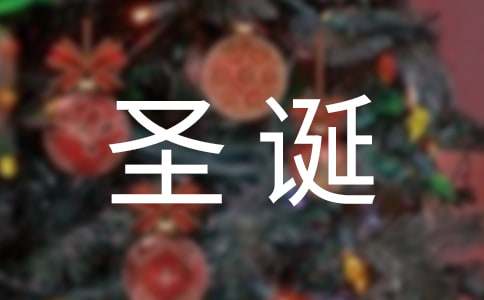盘点各国奇异圣诞风俗
Christmas was brought into China several years ago and only celebrated by a few people to begin with but it is now almost universally accepted.

In China
Christmas has been well received because the people already enjoyed giving gifts to each other.
Santa Claus has been easily accepted by Chinese people - a kindly man who carries a huge pack with red hat and black boots.
In England
Christmas is celebrated on December 25th.
Children write letters to Santa detailing their requests for Christmas gifts.
Gifts are traditionally opened on Christmas afternoon.
Stockings are hung up and filled with small gifts, fruit and nuts.
Christmas carols were first sung.
People like to kiss under the mistletoe.
Boxing Day is a unique holiday for this country. Boxing Day was traditionally a day for giving to the less fortunate.
Christmas dinner is usually a Roast Turkey with Christmas pudding and mince pies for dessert.
Christmas decorations must be taken down on the Twelfth Day after Christmas otherwise it brings bad luck for the rest of the year.
Santa is known as Father Christmas.
In Australia
It never snows at Christmas.
Christmas is in the summer holiday.
Christmas is always early.
A traditional Christmas dinner is often held in the backyard for BBQ's, picnics in the garden or even on the beach.
A typical Christmas menu could include cold meats, pasta, salads and fruit.
Santa is also known as the Swag Man.
The first official Christmas was on December 25th 1788.
We do not follow the American ritual of having real Christmas trees.
There is a harmonious mix of ethnic groups, so there are many culturally diverse Christmas celebrations.
People call the Christmas season the "silly season".
In Spain
Christmas is a deeply religious festival.
The Christmas season officially begins on December 8th.
Christmas Eve is known as the "Good Night". It is a time for family members to gather together to rejoice and feast around the Nativity scenes that are present in nearly every home.
A traditional Christmas treat is turron, a kind of almond candy.
December 28 is the feast of the Holy Innocents. Young boys of a town or village light bonfires and one of them acts as the mayor who orders townspeople to perform civic chores such as sweeping the streets.
Refusal to comply results in fines which are used to pay for the celebration.
Children receive gifts on January 6th - the feast of the Epiphany.
Children leave their shoes on the windowsills and fill them with straw, carrots, and barley for the horses of the Wise Men.
Their children's favorite Wise Man is Balthazar who rides a donkey and is the one believed to leave the gifts.
People say "Feliz Navidad" for Merry Christmas.
Santa Claus is called Papa Noel and some children will also receive presents from him on December 24th.
In Russia
St. Nicholas is extremely popular.
St.Nicholas is also known as Grandfather Frost.
New Year Day is the main holiday.
Father Frost delivers presents on New Years Eve.
Traditionally a figure called Babushka gave gifts to the children. Babushka is an old woman or grandmother with a headscarf tied under the chin.
Christmas is celebrated on January 7th.
Christmas day begins at midnight with churches ringing in the day with magnificent choral chanting.
Christmas Eve dinner does not contain any meat.
People eat a special porridge called "Kutya." This is made of wheat berries or other grains, which symbolize hope and immortality, and honey and poppy seeds, which ensure happiness, success, and untroubled rest.
A ceremony involving the blessing of the home is frequently observed. A priest visits the home accompanied by boys carrying vessels of holy water, and a little water is sprinkled in each room.
In Germany
They hold special markets every December that specialize in selling decorations and other Christmas related paraphernalia.
The people make and drink a spiced wine, which is called "mulled wine" in English and "Gluhwein" in their own language.
One of the famous traditional Christmas toys is the Nutcracker doll that now comes in many different styles.
The "Advent Calendar" originated here and is now used by children in many other countries that celebrate Christmas.
The Advent Calendar is used for counting down the days to Christmas and has twenty-four little doors with a picture and sometimes chocolate behind each one.
Children leave out a sock on December 6th for Saint Nicholas to fill with candies.
Families gather together on Christmas Eve to open their presents.
A traditional cake is eaten at Christmas time, called "Stollen" cake. It is very rich, fruity and coated with marzipan and icing sugar.
The Christmas tree originated.
At Christmas time if you been a bad boy or girl you will be visited by the evil Hans Muff and receive nothing.
In France
Every home displays a nativity scene featuring little clay figurines made in the south of this country.
The Christmas tree has never been popular here.
In many areas children receive gifts from Pere Noel.
They receive gifts on both December 6th and Christmas Day.
In other regions the gifts are delivered by "Le petit Jesus".
There is a traditional grand feast every year held after midnight mass on Christmas Eve.
A world famous cake is baked for the Christmas season in the shape of a log, usually coated in chocolate and extremely delicious.
One part of the country celebrates Christmas by eating turkey and chestnuts.
The capital city celebrates by eating oysters.
Adults wait until New Years Day to exchange gifts.
【盘点各国奇异圣诞风俗】相关文章:
各国圣诞风俗大盘点12-24
关于各国饮茶的风俗大观07-18
世界各国的风俗礼节07-17
奇异博士经典台词对白盘点11-12
盘点荷兰的风俗禁忌07-17
各国圣诞节习俗07-15
各国圣诞节习俗07-15
世界上绝无仅有奇异风俗07-17
异域国度的一些奇异女人风俗07-17
